Table of contents
- BMW electrifies semi-autonomous driving Electric shock alertness
- BMW shocks the driver – slightly
- opinion poll
- Conclusion

BMW motorcycle
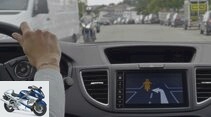



17th pictures
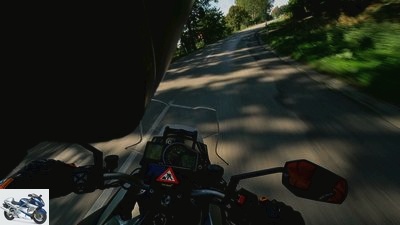
1/17
This is how the warning of an upcoming construction site that was previously not visible on the curve could look like. The key to this, however, is an absolutely precise location of the motorcycle and the construction site via GPS.
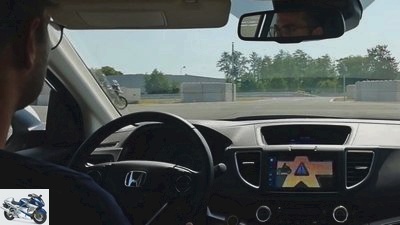
2/17
In the car, too, the motorcyclist must be recognizable via optical and / or acoustic signals. Especially when turning …
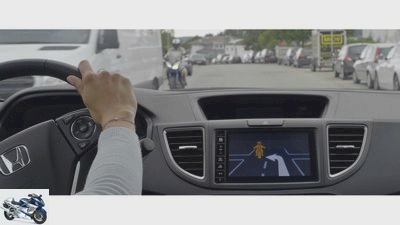
3/17
… or if the motorcycle is invisible behind another vehicle despite the minimum distance.

4/17
Just imagine. The car’s ESP detects a slippery spot on the road and communicates this to the oncoming motorcycle. Great.

5/17
Often tricky: wanting to overtake a slow, large vehicle and not know exactly what is going on in front of the truck. Here, the motorcyclist would be warned about the possible evasion of the truck.
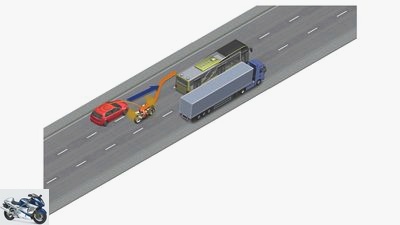
6/17
Classic blind spot warning. However, not via sensors or radar, but via the radio network of the C-ITS and GPS.
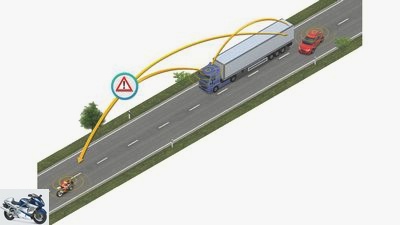
7/17
Conversely, the car is warned of an approaching motorcycle before overtaking.
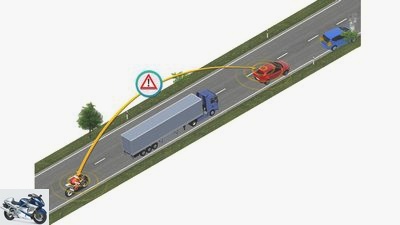
8/17
But the overtaking motorcycle is also warned of the slow traffic in front of the truck.
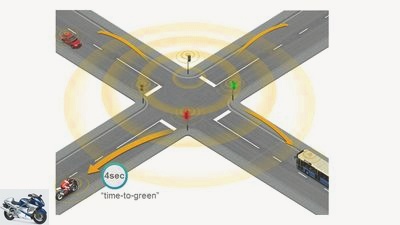
9/17
Nice aspect: In city traffic, all C-ITS vehicles are shown the optimal speed for the green wave.
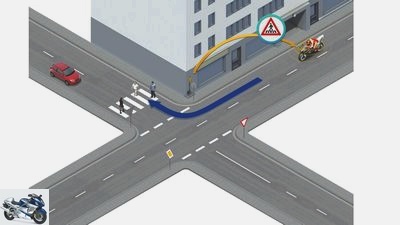
10/17
Via permanently installed antennas, crossing pedestrians can be recognized in good time …
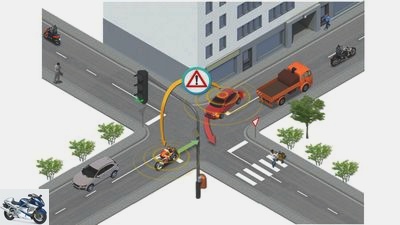
11/17
… or critical turning situations can be defused in good time via the C-ITS network.
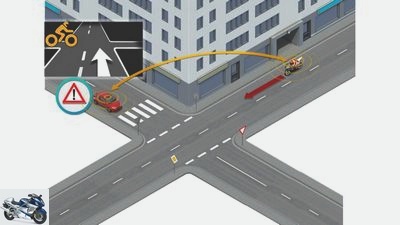
12/17
Conversely, the car is shown the approaching motorcycle well before it reaches the line of sight.
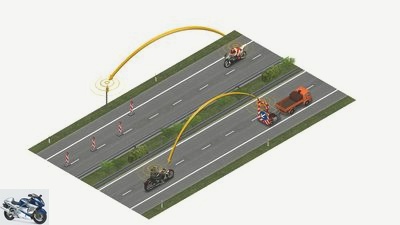
13/17
Brave new world: Construction sites and lane changes are automatically communicated to the motorcycle and all other networked road users.
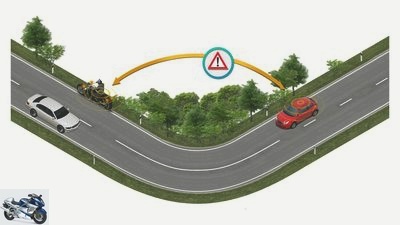
14/17
In the event of a breakdown, you cannot always choose where to stand. Here the motorcycle warns all other vehicles in good time before they reach the danger zone.
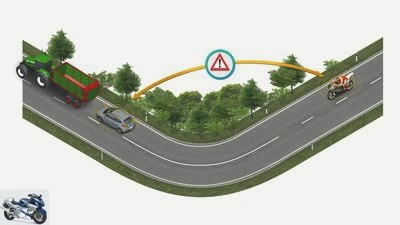
15/17
Also experienced 1,000 times. Sudden rolling obstacles after the turn. It’s nice to be warned in advance from your own bike.
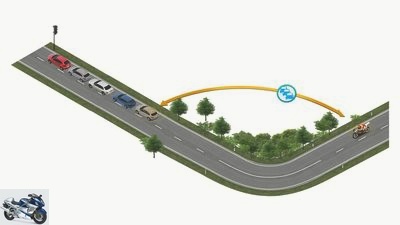
16/17
The same also applies to congestion in front of traffic lights, roundabouts or intersections.
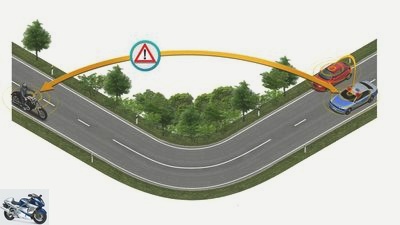
17/17
Another interesting aspect of the C-ITS for motorcycles is the timely detection of approaching rescue vehicles.
counselor
technology & future
BMW Motorrad patent: electrical stimulation for semi-autonomous driving
BMW electrifies semi-autonomous driving
Electric shock alertness
In order to expand the semi-autonomous driving aids on motorcycles, the systems must be sure of the driver’s attention and body tension. BMW thinks of small electrical surges in driver’s clothing.
Jens Kratschmar
March 29, 2021
As a member of the Connected Motorcycle Consortiums (CMC) BMW is one of the manufacturers who are committed to networking motorcycles with other road users. As an intermediate step, however, further series production readiness of further active driving safety systems that have a semi-autonomous function is necessary. The emergency brake assistant as an example. But steering aids or lane departure warning systems are also part of it. Important for all functions that change the current driving position: The driver has to be aware of this. An autonomous steering impulse from the motorcycle to avoid a hazard can increase this risk if the driver is inattentive. And the chance of an inattentive driver is great in such a situation, otherwise the system wouldn’t have to work. In the picture gallery we show how motorcycles could be networked.
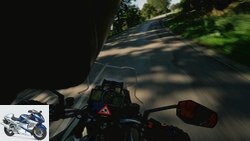
technology & future
Connected motorcycles are coming
BMW, Honda, KTM and Yamaha network us
read more
BMW shocks the driver – slightly
BMW motorcycle has applied for a patent in which an electrical stimulation device in the driver’s clothing tenses the muscles in the torso or abdomen and the driver can compensate for the impending intervention in the steering or heavy braking. Without this tension, the driver’s body would make a countermovement due to its inertia and thus disrupt the maneuver or even be thrown from the motorcycle itself.
For this purpose, at least one area of the motorcycle clothing near the driver’s skin should be equipped with such a stimulation device. The principle is known from rehabilitation or the fitness studio and stimulates the nerves, which then tense the muscles. BMW is thinking of protective clothing, underwear or racing suits that are wirelessly connected to the motorcycle’s safety system and thus enable stimulation.
opinion poll
Voted 1620 times
Connected motorcycles make traffic safer?
Yes, in any case.
No, no system can help without consideration for others.
read more
Conclusion
Speck away when braking. Interesting thought. But joking aside: The current possibilities of semi-autonomous motorcycle driving aids are limited by the driver component. Since the manufacturers cannot give the motorcycle any clues as to what the rider is doing on the motorcycle, features such as emergency braking assistants are difficult to implement.
BMW takes a different approach: If I don’t know what the driver is doing, then I have to make sure that he does what I need. Electrostimulation of the core muscles can be one way. And if you take a look around the CMC, you will also find Alpinestars as partners. So it is thought in the direction of making motorcycle clothing an active part of future systems.
Related articles
-
BMW Motorrad patent for gesture control
BWM counselor technology & future BMW Motorrad patent for gesture control BMW Motorrad patent for gesture control Guide with your fingers The functions…
-
Concept study BMW Motorrad Vision Next 100
BMW motorcycle 20th pictures BMW motorcycle 1/20 BMW Motorrad Vision Next 100. BMW motorcycle 2/20 BMW Motorrad Vision Next 100. BMW motorcycle 3/20 BMW…
-
Driving tips and advice on motorcycling
fact 26th pictures MOTORCYCLE 1/26 On the way on alpine passes? That’s how it works! MOTORCYCLE 2/26 Seductive winding curves with risk. The course of…
-
Zero FXE: electric supermoto in the driving report
News 2022 New motorcycle items for 2022 Zero Motorcycles 13th pictures Zero Motorcycles 1/13 Zero shows the new FXE and remains surprisingly close to the…
-
Driving report Brough Superior S.P. 100
Kyoichi Nakamura motorcycles Driving report Brough Superior S.P. 100 Driving report Brough Superior S.P. 100 Rebirth A legend has resurrected: the famous…
-
Artist motorcycles Super athlete Driving report Ducati 999 Driving report Ducati 999 (2004) Facelift The Ducati 999 has so far not been spoiled by sales…
-
Driving report and driving license Tuk-Tuk
Henniges motorcycles Driving report and driving license Tuk-Tuk Driving report and driving license Tuk-Tuk Danger Zone Thailand’s tuk-tuk drivers and…
-
Driving report Suzuki GSX-R 600 (2008)
Suzuki motorcycles Super athlete Driving report Suzuki GSX-R 600 (2008) Driving report Suzuki GSX-R 600 (2008) Gixxer with a new swing The new GSX-R 600…
-
Driving report Derbi Senda R 125 4T and SM 125 4T
Gargolov motorcycles Driving report Derbi Senda R 125 4T and SM 125 4T Driving report Derbi Senda R 125 4T and SM 125 4T Path of youth Senda comes from…
-
No new basis for motorcycle driving bans
Motorcycle noise Debate about the volume of motorcycles Ralf Schneider counselor traffic & business No new basis for motorcycle driving bans Amendment of…